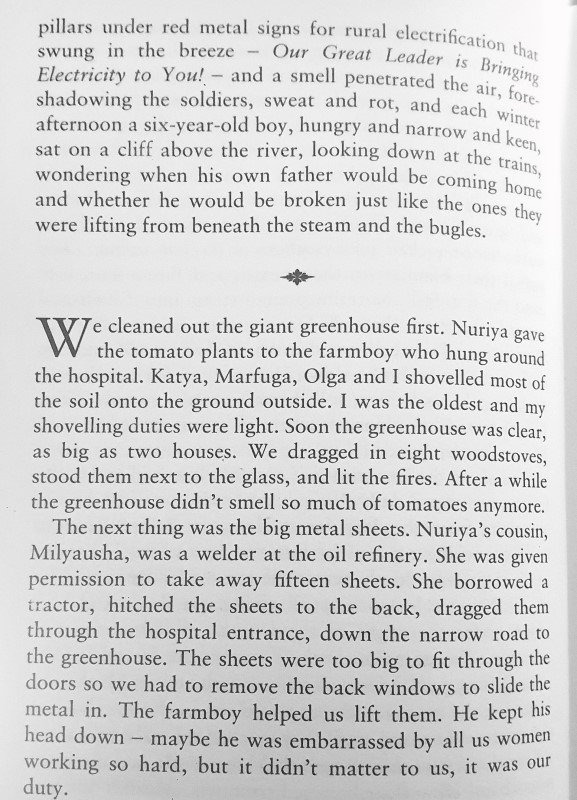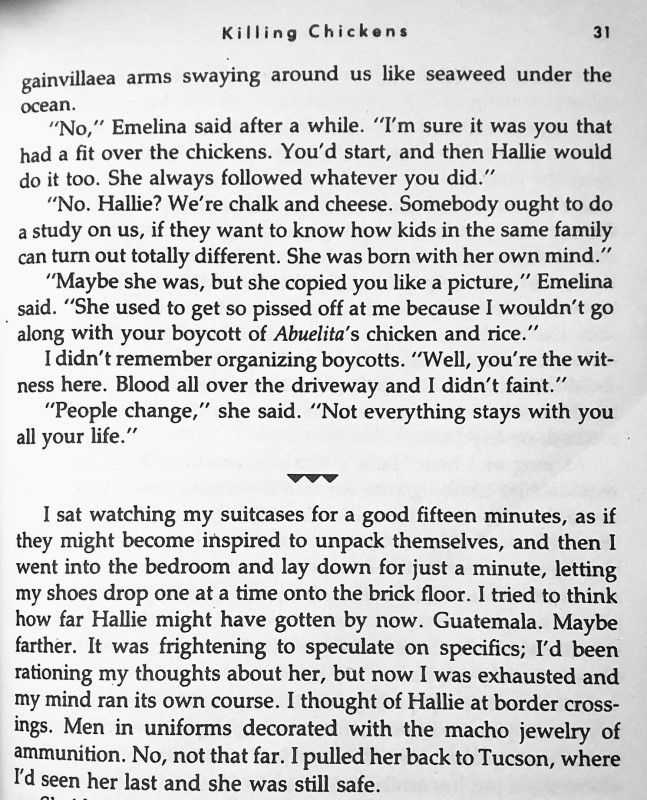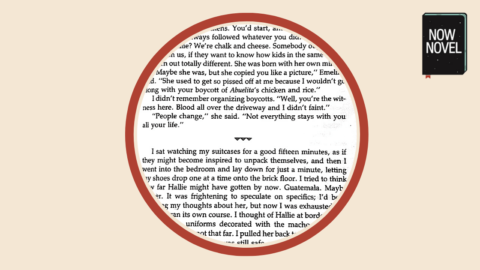The dinkus – a a typographic symbol between story or essay sections – is a source of confusion to many writers. To use, or not to use? What is a dinkus actually for? Read a definition of the dinkus, plus 6 ideas on creative ways to use them:
Scene break markers: When to use a dinkus
- What is a dinkus?
- Help readers navigate
- Shift sense of scale
- Fragment narration
- Give readers breathers
- Emphasize key moments
- Add stylistic or literary effect
What is a dinkus?
A dinkus is a symbol inserted between sections of text in order to make section or scene breaks clear. It’s typically used as a paragraph divider or a horizontal divider.
Brandon Taylor, in a humorous article about how dinkuses are (over)used (particularly in digital publishing), describes their function:
It’s a way to delineate a section break from a page break, a way to cue the reader that a transition is coming, a movement into something else. A string of three asterisks together is called a dinkus, and they are commonly used in fiction and in nonfiction to carve up larger sections into smaller still sections. They’re a kind of organizational tool that, in print media, is especially useful when dealing with fragmented texts.
Brandon Taylor, ‘I Reject Your Asterisks, and Your Dinkus, Too’ (2018), via Literary Hub
There are many other ways to indicate section breaks, of course. Many modern novels forego the three asterisks of the dinkus for a single asterisk, or use an alternative symbol, as Column McCann does in Dancer in the example below:

It’s also worth considering that if a writer were to forego such a symbol, and just use white space, or extra space, or a space between paragraphs, this might be considered an error. But, there are some novels that do this anyway. In the end it’s a personal and editorial style. The publishing house might have their own set of rules regarding the dinkus. What it doesn’t do is signal a chapter break.
Here are 6 ideas about how you can use a dinkus to:
1. Help readers navigate
One use of the dinkus, as Daisy Alioto puts it, is ‘navigation’:
Much like the stars, the dinkus is a point of navigation.
Daisy Alioto, ‘Ode to the Dinkus’ (2018), The Paris Review
Say, for example, you want to transition abruptly between a character’s memories when they were six years old and present action taking place elsewhere.
Column McCann does this in the example above (although using a symbol in place of a dinkus).
Between the description of a boy sitting on a river cliff watching the trains and waiting for his father to come home when he was six, and the description of a group clearing out a greenhouse, there’s a substantial shift in both time-period and place.
Here, a symbol like the dinkus is like a palate cleanser between courses. It helps the reader clear the lingering impression of the previous section to pay full attention to the complex flavours of the next.
2. Shift sense of scale
Often, you see a dinkus used when a narrative shifts in scale.
One section might show an intimate, detailed conversation between characters.
The next might shift into historical narration about significant background events during the year in which the conversation takes place.
A scene break between these sections would signpost the ‘movement into something else’ Brandon Taylor describes above. We move into a different sense of scale, from the individual, precisely situated scene to the broader, general and historical.
3. Fragment narration
One of the criticisms of using the dinkus to divide sections Taylor makes is that it takes us out of the scene and flow of a piece of writing.
This is particularly the case in digital writing, he says. When we read a piece in a continuous scroll online, telling the difference between page and section breaks is moot, he argues.
Yet you can use a dinkus precisely for this ‘fragmenting’, ‘pulling-us-out-of-the-scene’ effect.
For example, you may want to write a scene where lots is happening in different places, simultaneously.
Cutting between briefer sections with a dinkus (or single asterisk) between each could suggest the tumult and simultaneity of the events described.

4. Give readers breathers
Scene breaks within chapters are useful for creating a breather.
For example, if a passage of narration gives complex concepts, or there’s a non-step action scene but there are still further, separate developments necessary before closing the chapter.
A Reddit user in a discussion about Taylor’s article on the dinkus says they appreciate the ‘mini mental break’ a section break provides:
I don’t use asterisks/dinkus/whatever but with long pieces I appreciate it when it’s there. It’s like a mini mental break. I don’t know why it helps me, but it does.
Reddit user Um_Gayeb, in the /r/writing subreddit
5. Emphasize key moments
A scene break is useful for emphasizing key moments.
Say for example, you wish to draw attention to a memorable statement a character makes.
In the below example, Barbara Kingsolver uses a dinkus (though it’s written as three triangle wingdings instead of asterisks) in a way that creates emphasis on the character’s words right before the break.
The protagonist Codi has come to stay with her friend Emelina, and is watching her sons slaughter and prepare a chicken. Codi tells Emelina about her sister Hallie protesting their abuelita (grandmother) slaughtering chickens, and Emelina corrects here, saying it was Codi herself who led the protesting:

Kingsolver uses the dinkus here between scenes after Emelina’s words ‘not everything stays with you all your life’. Her words resonate with other experiences Codi has, such as returning to her hometown at the start ofthe chapter; a hometown in which she feels like an outsider and isn’t particularly close to her father.
The position of the dinkus helps to draw our attention to the way this idea resonates with other elements of Codi’s character arc.
6. Add stylistic or literary effect
When Daisy Alioto spoke to the editor in chief of Electric Literature, Jess Zimmerman, about the dinkus, Zimmerman said:
“I’ve seen people complain, Why is this three-asterisk thing so overused? I think one of the objections is that it feels self-consciously literary. But it is. Things that are tools for us as writers are also things that we can lend to the reader as a way of showing them how to read the piece.
Jess Zimmerman, quoted by Daisy Alioto in ‘Ode to the Dinkus’
As Zimmerman says, you can use any of the tools available to you as a writer. It’s up to you whether you use a dinkus to signal scene transitions within chapters, or divide historical and current narrative time.
As long as it aids rather than hinders clarity, the dinkus provides one more way to create interesting structure and juxtapositions.
Want to write structured, effective scenes? Get our free guide to scene structure now.


29 replies on “The dinkus: 6 uses for scene breaks”
This is WRONG – ‘or use an alternate symbol,’. The word you should have used is ALTERNATIVE. Alternate does NOT mean the same.
Thank you for the feedback, Julie! Well spotted. In actual fact alternate is given by Oxford Languages as an alternative for alternative with the following definition:
NORTH AMERICAN
another term for alternative.
“a novel set in an alternate universe”.
However given the geographical diversity of our readership we’ve corrected the ‘error’. Thanks for reading!
Well thanks to Julie we all know that you’re wrong now! That was rude as hell to point that out. I guess she wants us all to know how smart she is. (SMH)
Hi Mark, no harm done – Julie evidently felt strongly about the word alternative. Of course, there are tactful ways of giving feedback too that never hurt. Thank you for reading our blog.
I happen to think Julie was WRONG to demonstrate to everyone how clever she feels she is. But that aside, I came here to brush up on my dinkuses and I now know far more than I did ten minutes ago! Thank you.
Hi Jon, thank you! I’m glad you found this article on dinkuses and scene breaks useful. Don’t worry about Julie’s feedback (which was also technically incorrect). Everyone makes mistakes (which is why editors talk about ‘acceptable error rates’ and you will find books such as Tolkien’s LOTR cycle which had something like 100 corrections or more for its 50th anniversary edition).
Jordan, Thank you for being gracious about accepting feedback and engaging with a reader respectfully. Jon and Mark, your eagerness to denigrate Julie also perpetuates the rudeness you are ostensibly decrying. Methinks if Julie had been Jules and Jordan had been Jane, tempers wouldn’t be flaring so much. Women are smart, you know, and Julie is clearly smart – why does that upset you so? If she could have been kinder about her feedback then say so without getting your panties in a bunch that a woman dared to show her knowledge (even if that knowledge was technically incorrect for American English). My two bits. Too much vitriol about these days.
Hi LHN, it’s a pleasure and I hear what you’re saying. I agree re: vitriol, though I did also read the prior comments as reacting to the rudeness of correcting a person using all caps rather than civilly (rather than as necessarily evidence of misogyny) as it isn’t the most tactful option and is not a tone I would personally use in giving feedback.
The reason I make this distinction is I think it’s perhaps easy to reduce an argument to identity-politics-aligned positions, but ultimately the thread evolved the way it did due to absent courtesy and interpersonal consideration in OP’s tone which I do not see as gendered. Any gender is capable of tact and (hopefully) more kindness and less vitriol. It’s good to have different viewpoints and responses – far better than echo chambers (ad hominem of course serves no purpose).
For nearly 62 years I have never known the name for that wonderful set of asterisks! Jordan – I cannot thank you enough for this information. Most useful. Now that I have had the great fortune to come across you site, I will be reading what you have to say in detail.
Blessings. John.
Hi John, 62 years is a very long scene break 🙂 I’m glad to hear you found this article helpful, it’s a pleasure. Please do share further thoughts or questions on anything you find that interests you, we value our readers’ insights and questions.
how do you put a dinkus in a word document?
You can either type in a single asterisk, three asterisks, or insert a special character if using one (for example in The Shipping News E. Annie Proulx uses a graphic of a tied knot which fits in with the themes of the story and the chapter subtitles which also elaborate on different kinds of knots).
Julie was not wrong
Jordan, your a piece of crap
Hi Sophie, thanks for the feedback. While we’re on the subject of corrections, please note the word you want is ‘you’re’ (contraction of you are), or else if using the possessive you would not need the indefinite article (as in, “Jordan, your piece of crap [verbal phrase to complete the sentence here]”).
This comment thread is comedy gold. I haven’t laughed this hard in a long time. Thank you, everyone.
I’m glad you enjoyed it, Jens 🙂
Jordan,
My editor threw a dinkus in the middle of one of my chapters and her reasoning was “change of POV.” Is this accurate and/or necessary? My proofer questioned it as it looks odd in the middle of my character’s conversation. Any advice would be great!
Hi Joe, it is a little odd (and I would even say incorrect) for there to be a scene break in the middle of a conversation, since the scene would not have ended. But does the point of view change mid-conversation? Is there a reason it has to? If not, I would probably move it to after the conversation as that would likely be more appropriate as the end of a sequence of action. However it’s difficult to say without seeing the scene in question. Scene breaks usually are placed between scenes, when there is a change of viewpoint character, location, or other shift that warrants a longer pause.
I have always thought(not assumed 😉 ) that a dinkus was used for the transition at either the top of or bottom of the paper page. And noticed that many authors simply use double or triple space to signify a transition in digital print. I do know that this double/triple spacing is also used in paper books. Is this then a wrong assumption?
Hi Harry, formatting choices do vary a little when it comes to dinkuses (dinkii?). The main thing is to be consistent. I wasn’t aware of a rule a dinkus has to be at the top or bottom of the page, it would strike me as poor formatting if an asterisk were followed by dead space at the bottom of the page, for example. I’ve seen them used many times mid-page. I’m not sure offhand about digital, I’d have to go look (as I read far more in print than digital, preferring the medium generally). A comment via Stackexchange’s writing forum: ‘As has been mentioned, this is largely author choice. In my personal reading experience, however, space breaks generally indicate a passage of time, or a shifting of scenes. Dots seem to indicate a larger separation, but not large enough for a new chapter. A switching of POV comes to mind’.
Thanks Jordan. Actually that does indeed answer my slight confusion. I am still unsure if the author or editor inserts the dinkus, but it does clarify the ambiguity of its why and where the dinkus is used.
It’s a pleasure, Harry. Usually the author (as they will most often decide first where they want there to be a scene break), but if the editor thinks it would benefit the narrative structure they might too (in a developmental edit, not in copy-editing which doesn’t address that sort of structural decision of course).
Could you use a dinkus to imply a short time skip? As in a few minutes?
Hi bro, you could do so though I would say in most instances a narrative link such as ‘Minutes later…’ would do equally well to show a skip in time. Usually it would be used for larger changes, such as hours later, the next day, and/or location or viewpoint shifts.
I hope this is helpful! Thanks for your question.
Is there a set amount of words to use before a dinkus can be used or as long as it creates the effect (I.E.: change of scene/location) its fine.
Hi Robin, great question. I think you will get different answers from different readers/editors (i.e. it isn’t standardized to my knowledge). Typically, I would say use on at the end of a scene or between scenes. If you were to have a page with, say, five dinkuses (dinkii?), that would perhaps look a little unnecessary. The location/time/POV probably wouldn’t need to change that much in a page. In my editing, when a writer has used more than one or two in a chapter, I often recommend an additional chapter break instead, as if there is a suspenseful moment before one of them, that could also make a great cliffhanger to the next chapter. I hope this helps!
I was doing research on the dinkus and found this to be very informative and helpful. Thanks, Jordan. Also… did anyone else notice that half of the users in this comment thread have names/usernames that begin with the letter J?
Hello Jay, great to hear your comment, thanks for writing in. The dinkus is a really useful tool to use!